Pathophysiology of Diseases: Hypovolemic Shock, Heart Attack, Ulcers
VerifiedAdded on 2022/08/20
|5
|914
|23
Homework Assignment
AI Summary
This assignment delves into the pathophysiology of several critical medical conditions. It begins with an examination of hypovolemic shock, detailing its phases (compensated, decompensated, and irreversible), vascular manifestations, and treatment involving IV fluids and dobutamine. The assignment then explores the pathophysiology and pharmacology of chest pain associated with myocardial infarction (heart attack), explaining the role of blood clots, hypoxia, and the use of aspirin. Furthermore, it investigates the pathophysiology of infections following coronary angioplasty, highlighting associated factors like stent placement and the organisms involved. Finally, the assignment addresses the pathophysiology of pressure ulcers, discussing the role of pressure, friction, shearing forces, and moisture in their development. The assignment includes references to support the information provided.
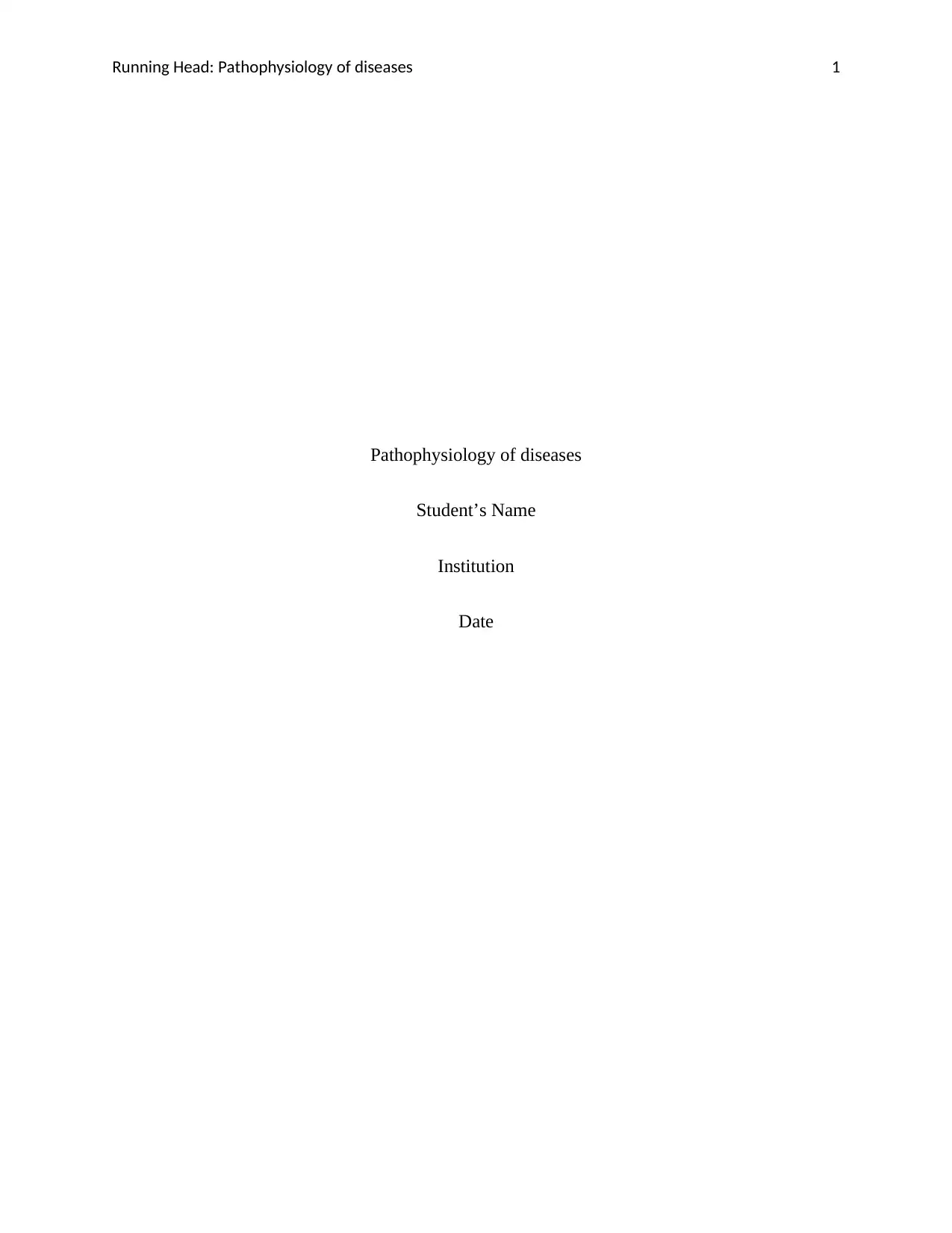
Running Head: Pathophysiology of diseases 1
Pathophysiology of diseases
Student’s Name
Institution
Date
Pathophysiology of diseases
Student’s Name
Institution
Date
Paraphrase This Document
Need a fresh take? Get an instant paraphrase of this document with our AI Paraphraser
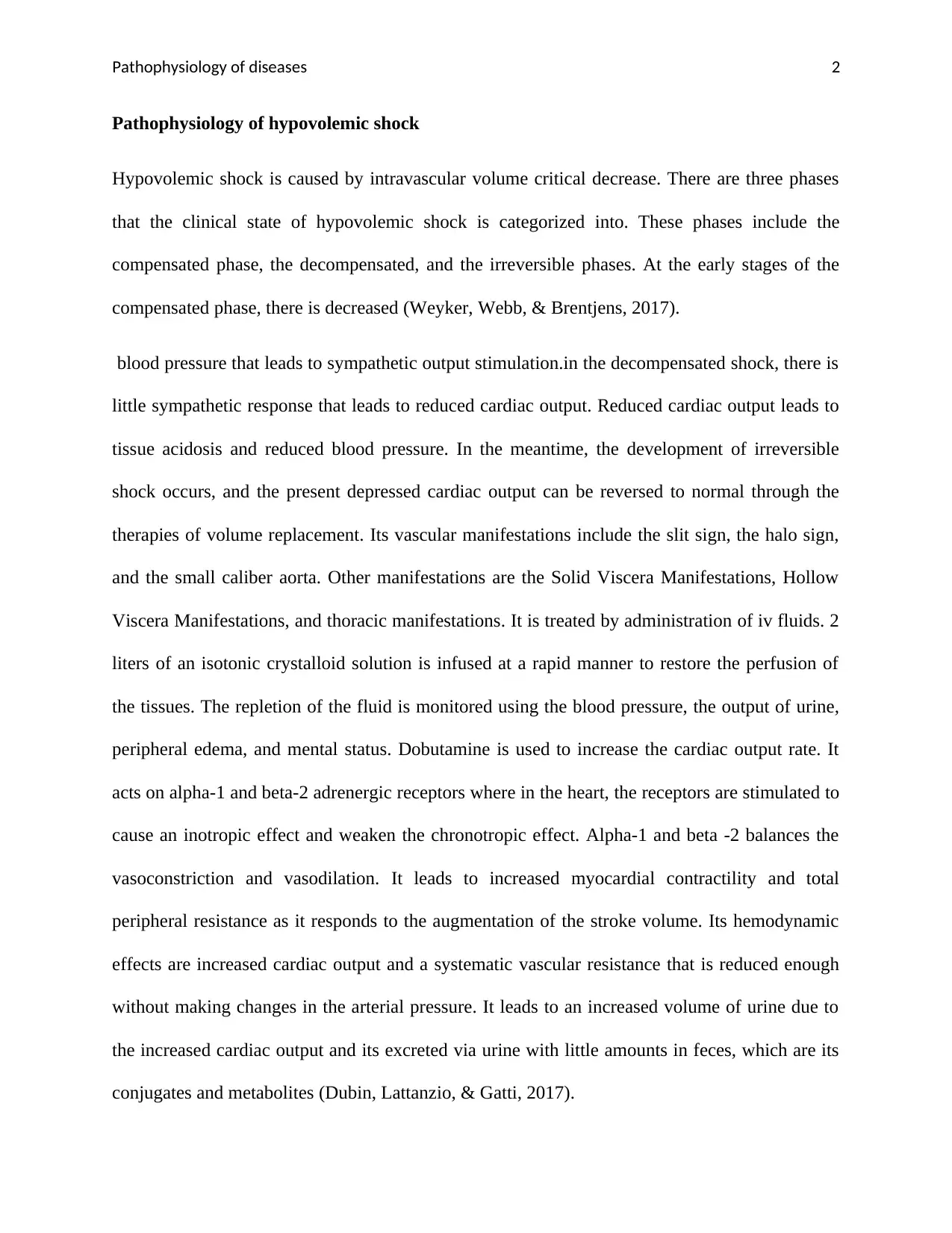
Pathophysiology of diseases 2
Pathophysiology of hypovolemic shock
Hypovolemic shock is caused by intravascular volume critical decrease. There are three phases
that the clinical state of hypovolemic shock is categorized into. These phases include the
compensated phase, the decompensated, and the irreversible phases. At the early stages of the
compensated phase, there is decreased (Weyker, Webb, & Brentjens, 2017).
blood pressure that leads to sympathetic output stimulation.in the decompensated shock, there is
little sympathetic response that leads to reduced cardiac output. Reduced cardiac output leads to
tissue acidosis and reduced blood pressure. In the meantime, the development of irreversible
shock occurs, and the present depressed cardiac output can be reversed to normal through the
therapies of volume replacement. Its vascular manifestations include the slit sign, the halo sign,
and the small caliber aorta. Other manifestations are the Solid Viscera Manifestations, Hollow
Viscera Manifestations, and thoracic manifestations. It is treated by administration of iv fluids. 2
liters of an isotonic crystalloid solution is infused at a rapid manner to restore the perfusion of
the tissues. The repletion of the fluid is monitored using the blood pressure, the output of urine,
peripheral edema, and mental status. Dobutamine is used to increase the cardiac output rate. It
acts on alpha-1 and beta-2 adrenergic receptors where in the heart, the receptors are stimulated to
cause an inotropic effect and weaken the chronotropic effect. Alpha-1 and beta -2 balances the
vasoconstriction and vasodilation. It leads to increased myocardial contractility and total
peripheral resistance as it responds to the augmentation of the stroke volume. Its hemodynamic
effects are increased cardiac output and a systematic vascular resistance that is reduced enough
without making changes in the arterial pressure. It leads to an increased volume of urine due to
the increased cardiac output and its excreted via urine with little amounts in feces, which are its
conjugates and metabolites (Dubin, Lattanzio, & Gatti, 2017).
Pathophysiology of hypovolemic shock
Hypovolemic shock is caused by intravascular volume critical decrease. There are three phases
that the clinical state of hypovolemic shock is categorized into. These phases include the
compensated phase, the decompensated, and the irreversible phases. At the early stages of the
compensated phase, there is decreased (Weyker, Webb, & Brentjens, 2017).
blood pressure that leads to sympathetic output stimulation.in the decompensated shock, there is
little sympathetic response that leads to reduced cardiac output. Reduced cardiac output leads to
tissue acidosis and reduced blood pressure. In the meantime, the development of irreversible
shock occurs, and the present depressed cardiac output can be reversed to normal through the
therapies of volume replacement. Its vascular manifestations include the slit sign, the halo sign,
and the small caliber aorta. Other manifestations are the Solid Viscera Manifestations, Hollow
Viscera Manifestations, and thoracic manifestations. It is treated by administration of iv fluids. 2
liters of an isotonic crystalloid solution is infused at a rapid manner to restore the perfusion of
the tissues. The repletion of the fluid is monitored using the blood pressure, the output of urine,
peripheral edema, and mental status. Dobutamine is used to increase the cardiac output rate. It
acts on alpha-1 and beta-2 adrenergic receptors where in the heart, the receptors are stimulated to
cause an inotropic effect and weaken the chronotropic effect. Alpha-1 and beta -2 balances the
vasoconstriction and vasodilation. It leads to increased myocardial contractility and total
peripheral resistance as it responds to the augmentation of the stroke volume. Its hemodynamic
effects are increased cardiac output and a systematic vascular resistance that is reduced enough
without making changes in the arterial pressure. It leads to an increased volume of urine due to
the increased cardiac output and its excreted via urine with little amounts in feces, which are its
conjugates and metabolites (Dubin, Lattanzio, & Gatti, 2017).
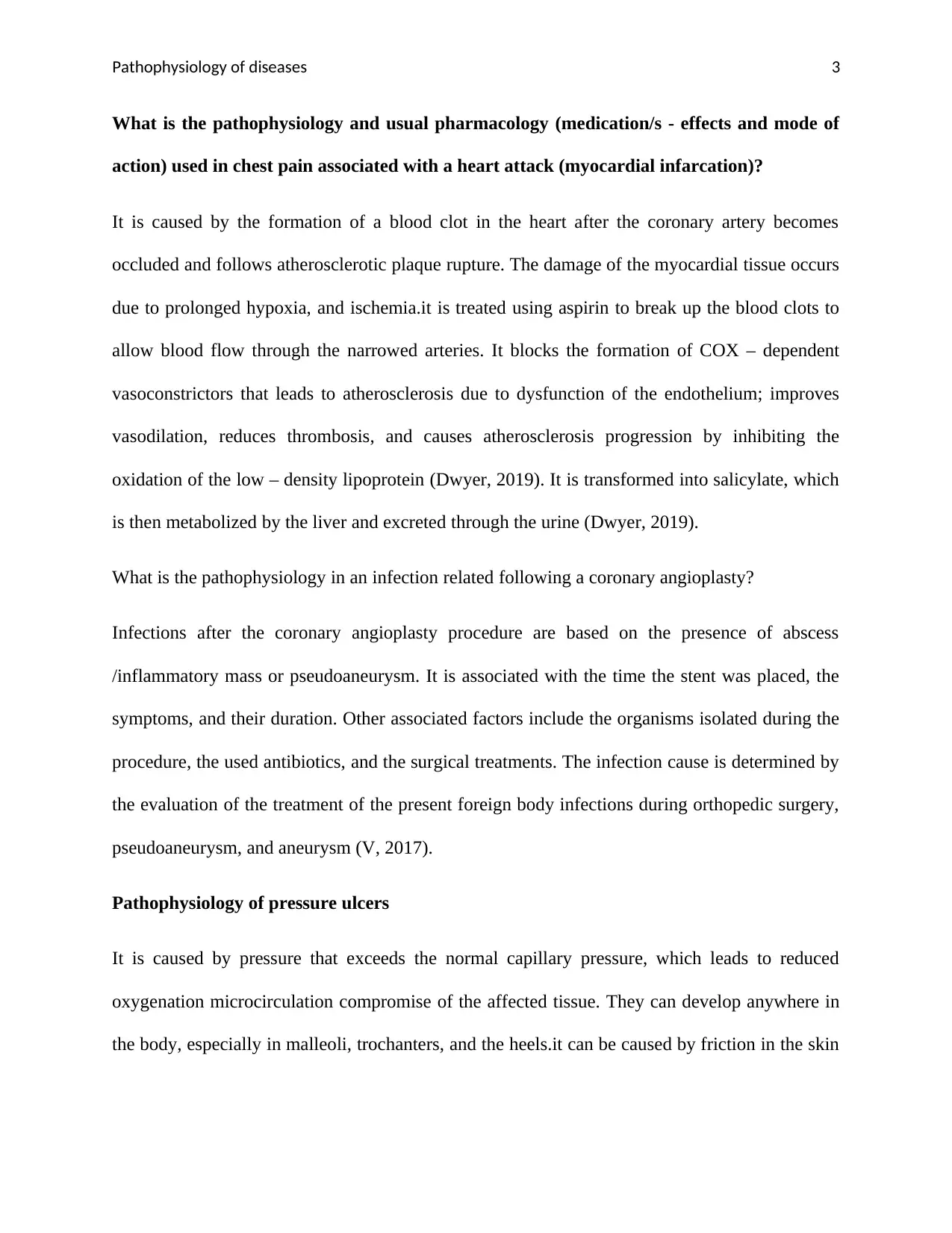
Pathophysiology of diseases 3
What is the pathophysiology and usual pharmacology (medication/s - effects and mode of
action) used in chest pain associated with a heart attack (myocardial infarcation)?
It is caused by the formation of a blood clot in the heart after the coronary artery becomes
occluded and follows atherosclerotic plaque rupture. The damage of the myocardial tissue occurs
due to prolonged hypoxia, and ischemia.it is treated using aspirin to break up the blood clots to
allow blood flow through the narrowed arteries. It blocks the formation of COX – dependent
vasoconstrictors that leads to atherosclerosis due to dysfunction of the endothelium; improves
vasodilation, reduces thrombosis, and causes atherosclerosis progression by inhibiting the
oxidation of the low – density lipoprotein (Dwyer, 2019). It is transformed into salicylate, which
is then metabolized by the liver and excreted through the urine (Dwyer, 2019).
What is the pathophysiology in an infection related following a coronary angioplasty?
Infections after the coronary angioplasty procedure are based on the presence of abscess
/inflammatory mass or pseudoaneurysm. It is associated with the time the stent was placed, the
symptoms, and their duration. Other associated factors include the organisms isolated during the
procedure, the used antibiotics, and the surgical treatments. The infection cause is determined by
the evaluation of the treatment of the present foreign body infections during orthopedic surgery,
pseudoaneurysm, and aneurysm (V, 2017).
Pathophysiology of pressure ulcers
It is caused by pressure that exceeds the normal capillary pressure, which leads to reduced
oxygenation microcirculation compromise of the affected tissue. They can develop anywhere in
the body, especially in malleoli, trochanters, and the heels.it can be caused by friction in the skin
What is the pathophysiology and usual pharmacology (medication/s - effects and mode of
action) used in chest pain associated with a heart attack (myocardial infarcation)?
It is caused by the formation of a blood clot in the heart after the coronary artery becomes
occluded and follows atherosclerotic plaque rupture. The damage of the myocardial tissue occurs
due to prolonged hypoxia, and ischemia.it is treated using aspirin to break up the blood clots to
allow blood flow through the narrowed arteries. It blocks the formation of COX – dependent
vasoconstrictors that leads to atherosclerosis due to dysfunction of the endothelium; improves
vasodilation, reduces thrombosis, and causes atherosclerosis progression by inhibiting the
oxidation of the low – density lipoprotein (Dwyer, 2019). It is transformed into salicylate, which
is then metabolized by the liver and excreted through the urine (Dwyer, 2019).
What is the pathophysiology in an infection related following a coronary angioplasty?
Infections after the coronary angioplasty procedure are based on the presence of abscess
/inflammatory mass or pseudoaneurysm. It is associated with the time the stent was placed, the
symptoms, and their duration. Other associated factors include the organisms isolated during the
procedure, the used antibiotics, and the surgical treatments. The infection cause is determined by
the evaluation of the treatment of the present foreign body infections during orthopedic surgery,
pseudoaneurysm, and aneurysm (V, 2017).
Pathophysiology of pressure ulcers
It is caused by pressure that exceeds the normal capillary pressure, which leads to reduced
oxygenation microcirculation compromise of the affected tissue. They can develop anywhere in
the body, especially in malleoli, trochanters, and the heels.it can be caused by friction in the skin
⊘ This is a preview!⊘
Do you want full access?
Subscribe today to unlock all pages.

Trusted by 1+ million students worldwide
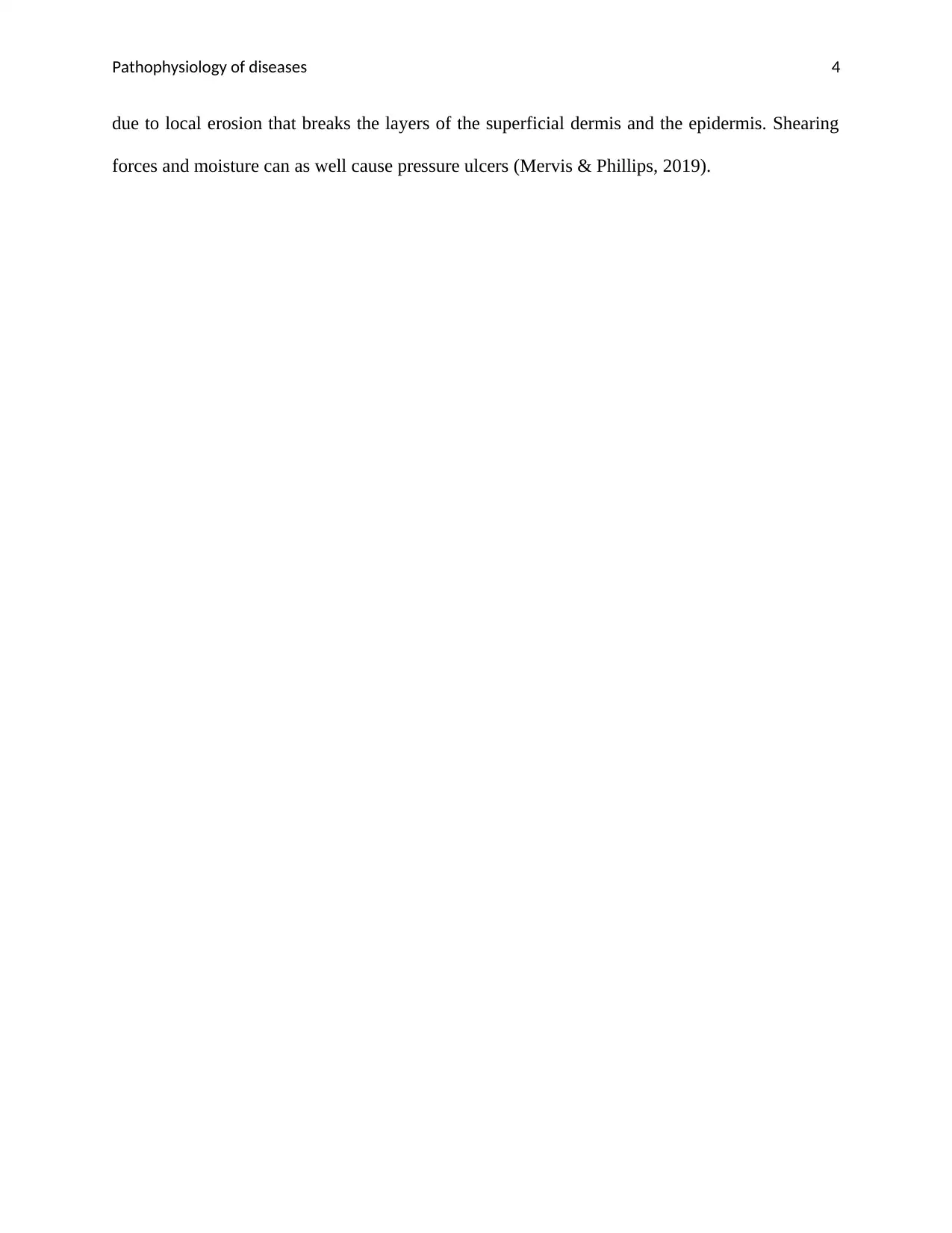
Pathophysiology of diseases 4
due to local erosion that breaks the layers of the superficial dermis and the epidermis. Shearing
forces and moisture can as well cause pressure ulcers (Mervis & Phillips, 2019).
due to local erosion that breaks the layers of the superficial dermis and the epidermis. Shearing
forces and moisture can as well cause pressure ulcers (Mervis & Phillips, 2019).
Paraphrase This Document
Need a fresh take? Get an instant paraphrase of this document with our AI Paraphraser
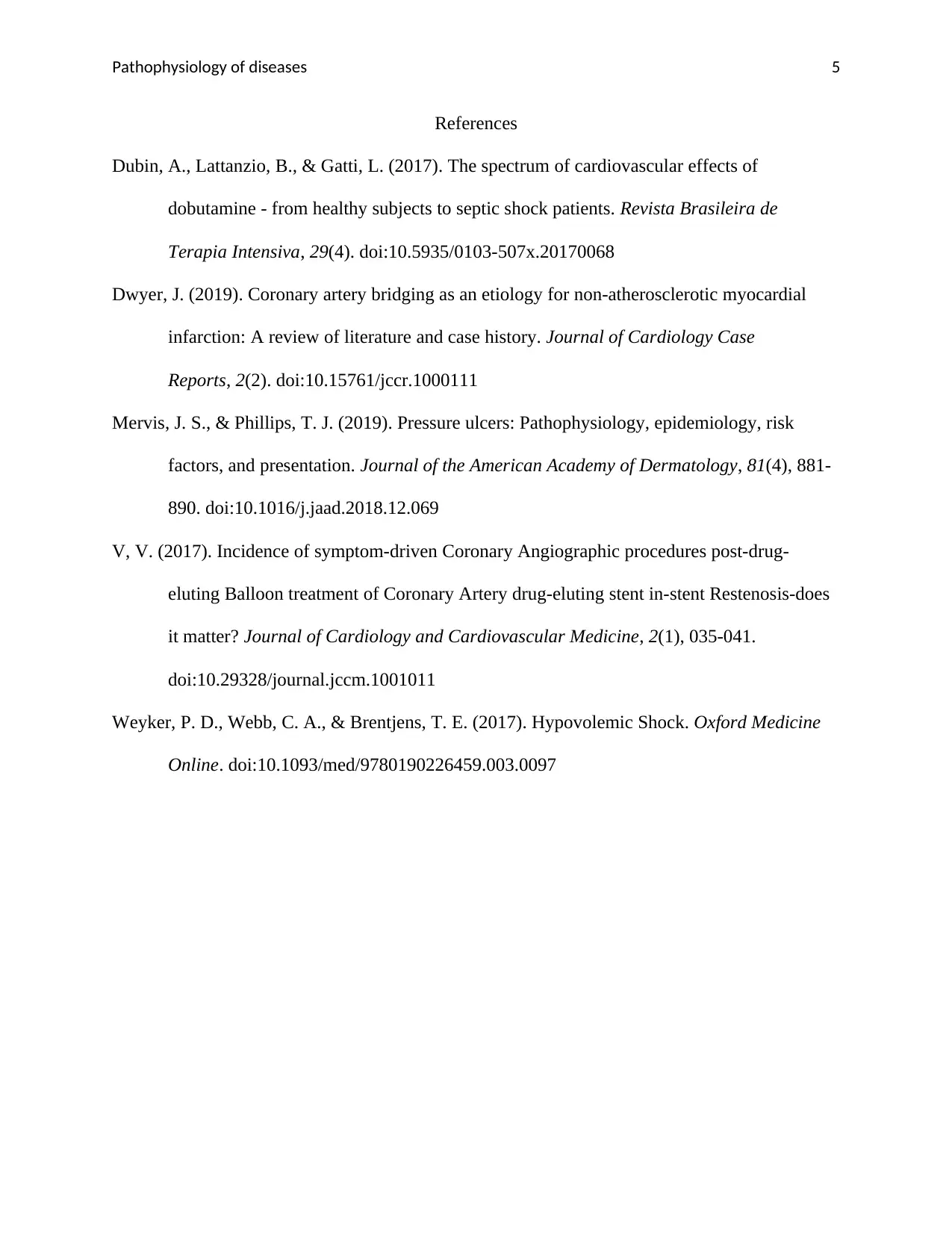
Pathophysiology of diseases 5
References
Dubin, A., Lattanzio, B., & Gatti, L. (2017). The spectrum of cardiovascular effects of
dobutamine - from healthy subjects to septic shock patients. Revista Brasileira de
Terapia Intensiva, 29(4). doi:10.5935/0103-507x.20170068
Dwyer, J. (2019). Coronary artery bridging as an etiology for non-atherosclerotic myocardial
infarction: A review of literature and case history. Journal of Cardiology Case
Reports, 2(2). doi:10.15761/jccr.1000111
Mervis, J. S., & Phillips, T. J. (2019). Pressure ulcers: Pathophysiology, epidemiology, risk
factors, and presentation. Journal of the American Academy of Dermatology, 81(4), 881-
890. doi:10.1016/j.jaad.2018.12.069
V, V. (2017). Incidence of symptom-driven Coronary Angiographic procedures post-drug-
eluting Balloon treatment of Coronary Artery drug-eluting stent in-stent Restenosis-does
it matter? Journal of Cardiology and Cardiovascular Medicine, 2(1), 035-041.
doi:10.29328/journal.jccm.1001011
Weyker, P. D., Webb, C. A., & Brentjens, T. E. (2017). Hypovolemic Shock. Oxford Medicine
Online. doi:10.1093/med/9780190226459.003.0097
References
Dubin, A., Lattanzio, B., & Gatti, L. (2017). The spectrum of cardiovascular effects of
dobutamine - from healthy subjects to septic shock patients. Revista Brasileira de
Terapia Intensiva, 29(4). doi:10.5935/0103-507x.20170068
Dwyer, J. (2019). Coronary artery bridging as an etiology for non-atherosclerotic myocardial
infarction: A review of literature and case history. Journal of Cardiology Case
Reports, 2(2). doi:10.15761/jccr.1000111
Mervis, J. S., & Phillips, T. J. (2019). Pressure ulcers: Pathophysiology, epidemiology, risk
factors, and presentation. Journal of the American Academy of Dermatology, 81(4), 881-
890. doi:10.1016/j.jaad.2018.12.069
V, V. (2017). Incidence of symptom-driven Coronary Angiographic procedures post-drug-
eluting Balloon treatment of Coronary Artery drug-eluting stent in-stent Restenosis-does
it matter? Journal of Cardiology and Cardiovascular Medicine, 2(1), 035-041.
doi:10.29328/journal.jccm.1001011
Weyker, P. D., Webb, C. A., & Brentjens, T. E. (2017). Hypovolemic Shock. Oxford Medicine
Online. doi:10.1093/med/9780190226459.003.0097
1 out of 5
Related Documents
Your All-in-One AI-Powered Toolkit for Academic Success.
+13062052269
info@desklib.com
Available 24*7 on WhatsApp / Email
![[object Object]](/_next/static/media/star-bottom.7253800d.svg)
Unlock your academic potential
Copyright © 2020–2025 A2Z Services. All Rights Reserved. Developed and managed by ZUCOL.



